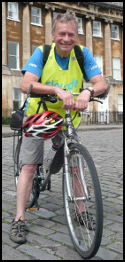Three months ago I wrote an article for the Local Government Association’s weekly magazine “First” in a section called “Last Word”, about 20 mph speed limits. Implementing 20 mph speed limits is one of the 10 commitments in the Times Safer Cycling campaign and the speed limits are being rolled out across Bath and North East Somerset Council’s area. The article is reproduced below:
As I look out of my window I can see three little girls riding their bikes in my street. A common occurrence here, where people in this quiet residential street are aware of children playing and are careful, but in other streets this is pretty unusual. In the past most children liked to play out close to home, but it is now more likely they will be kept indoors to play, because of the danger of speeding traffic going past.
Across the country 44 councils so far, have decided to implement “signs only” 20 mph speed limits. The usual justification for this move is to make
our residential roads safer. The Transport Research Laboratory found that approximately 98% of pedestrians will survive a 20mph collision. Their chances drop to around 93% at 30mph and 69% at 40mph.
However, putting in 20 mph speed limits in residential streets means more than just making streets safer. It is the beginning of a culture change where people on foot and on bikes, and children playing, take precedence over passing motor vehicles. It’s about giving control of streets back to the people who live in them.
Councils can do signs only “blanket” coverage for a fraction of the cost of 20mph zones, where there are physical measures such as speed tables, to prevent drivers from breaking the law. 20 mph zones, with restraints still have their place but with reducing funds less of them can be implemented by Councils.
Critics say that “signs only” 20 mph speed limits cannot be enforced, but then enforcement of any speed limit is difficult given reducing police resources, but that is not the point. If councils achieve a small reduction in speed it has a big affect on safety. Signs only 20 mph should be self enforcing by drivers, by becoming the default speed limit and exceeding it should become as rare as the non wearing of seat belts.
Government advice now encourages Traffic Authorities to consider 20mph restrictions not just in residential areas, but also on busier roads where the numbers of pedestrians and cyclists are—or could be—significant. A sure sign of a growing move to 20 mph.

 Hello, I'm Roger Symonds and I have created this blog to highlight local and wider cycling issues. Given the incredible interest and increase in cycling we must not miss this opportunity to provide the the infrastructure that gets even more people out on bikes in a safer environment.
Hello, I'm Roger Symonds and I have created this blog to highlight local and wider cycling issues. Given the incredible interest and increase in cycling we must not miss this opportunity to provide the the infrastructure that gets even more people out on bikes in a safer environment.
I think this is a real great article post.Much thanks again. Want more.
Hey, thanks for the blog article.Really looking forward to read more. Will read on…
You should take part in a competition for one of the finest blogs on the web. I will recommend this site!
Agree absolutely. As a Cyclist and as a member of the Institute of Advanced Motorists (I can’t claim to speak for them but I am Chief Observer of the local IAM Group, I help people who want to improve their driving skills by taking the Adavanced Test. It may surprise some to learn that the IAM supports the introduction of local 20mph limits).
Speed limits are too often ignored and anything that helps to make drivers think about the speed that they are travelling at and the effect that their vehicle could have if it were to collide with anything or anyone is good.
A vehicle is a potentially lethal weapon, driving is the most complex and dangerous task most of us will ever undertake. Drivers kill more than 2000 and seriously injure 250,000 on our roads each year.
If that many were killed in plane or train crashes something would be done about it. Yet it is just seen as a consequence of what most see as the ‘necessity’ of driving (when it is nothing of the sort).
Road Traffic Collisions are the single biggest cause of the loss of life, especially young males under the age of 25. It is a national scandal that very little is done to prevent the needless loss of so many lives and the tragic effects that collisions have on literally millions of people every year (others at the scene, the emergency services, family, friends, colleagues, wider society).
All the more scandalous since those deaths have been estimated to cost the economy £1M EACH, yes, each death costs every one of us a total ONE MILLION POUNDS – the cost of the initial collision and it’s immediate aftermath but also the loss of that persons contribution to society and the wasted cost of their education..
30mph is a limit not a target and 30mph is too fast in town and on residential streets. 20mph is far more appropriate.
I agree this is an absolute scandal. Despite the efforts of Road Peace http://www.roadpeace.org/ and BRAKE, the road safety charity http://www.brake.org.uk/